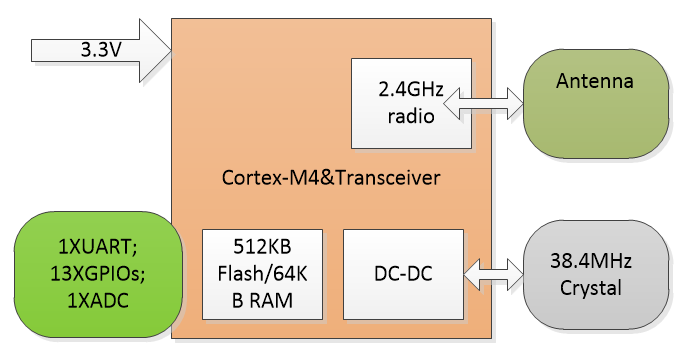TYZS11 Module Datasheet
Last Updated on : 2024-11-20 08:22:20download
TYZS11 is a low power embedded Zigbee module developed by Hangzhou Tuya Information Technology Co., Ltd. It consists of a highly integrated wireless radio processor chip (EFR32MG13P732) and several peripherals, with a built-in 802.15.4 PHY/MAC Zigbee network protocol stack and robust library functions.
After a period of service, this module will become deprecated due to product upgrades and iterations, user requirements, production inventory, or other reasons. To improve the compatibility of your smart devices and minimize the impact on your use, Tuya continues to provide webpage documentation of deprecated modules, but no longer maintains or updates the documentation. The content herein is for reference only.
If you have any questions, submit a ticket to contact Tuya or consult Tuya’s account manager to request support. If you need similar substitute products, see ZTU Module Datasheet.
Overview
TYZS11 is embedded with a low power-consuming 32-bit ARM Cortex-M4 core, 512 KB flash, 64 KB RAM data memory, and robust peripheral resources.
Figure 1 shows the architecture of TYZS11.
Figure 1 TYZS11 architecture
Features
- Built-in low power-consuming 32-bit ARM Cortex-M4 core with DSP instructions and floating-point unit functioning as an application processor
- Basic frequency: 40 MHz supported
- Wide working voltage: 1.8 V to 3.8 V
- Peripherals: 12 GPIOs, one UART, and one ADC
- Zigbee features
- 802.15.4 MAC/PHY supported
- Working channel: 11 to 26 @2.400 GHz to 2.483 GHz, with an air interface rate of 250 kbit/s
- Built-in DC-DC circuit, maximizing the power-supply efficiency
- Maximum output power: +19 dBm
- Power consumption when TYZS11 is working: 63 uA/MHz; current when TYZS11 is in the sleep state: 1.4 uA
- Copper column antenna and onboard PCB antenna
- Working temperature: -40°C to 85°C
- AES 128/256-based hardware encryption
Applications
- Intelligent building
- Intelligent home and household applications
- Intelligent socket and light
- Industrial wireless control
- Health care and measurement
- Asset tracing
Module interfaces
Dimensions and footprint
TYZS11 provides three lines of pins with a distance of 1.0 mm between every two pins.
TYZS11 dimension: 15.3±0.35 mm (W) x 22±0.35 mm (L) x 2±0.15 mm (H). The following figure shows the overall pin layout of TYZS11.

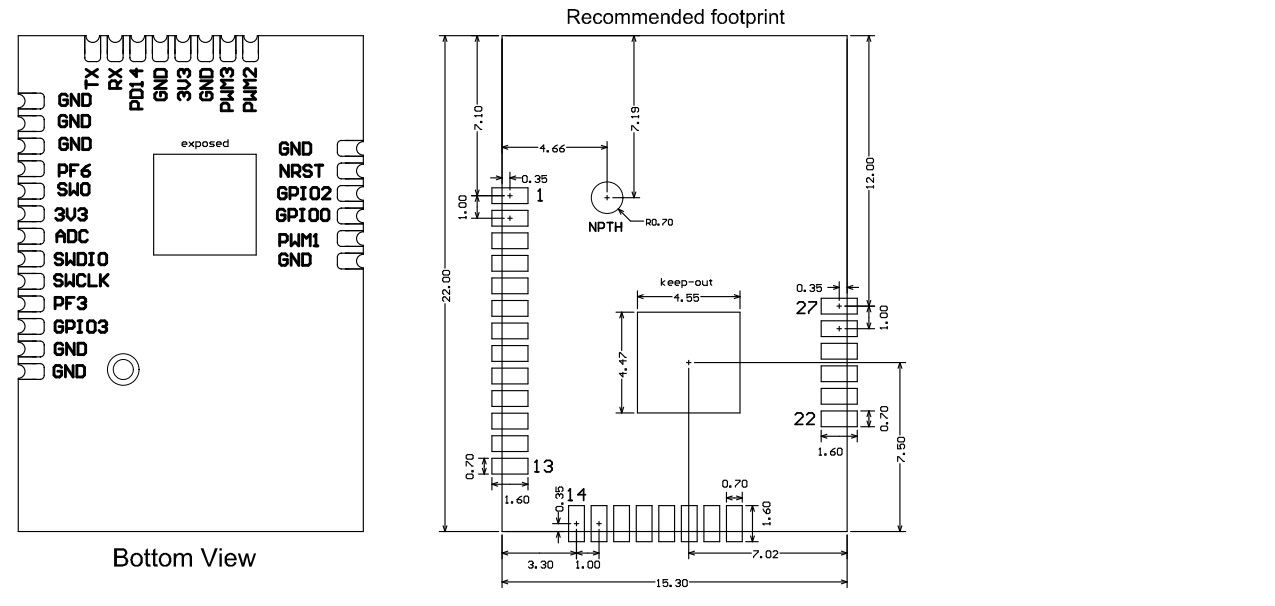
Pin definition
Table 1 describes the interface pins.
Table 1 TYZS11 interface pins
| No. | Symbol | I/O type | Functions |
|---|---|---|---|
| 1, 2, 11, 12, 13, and 17 | GND | P | Module reference ground pins |
| 19, 22, and 27 | |||
| 3 | GPIO3 | I/O | Corresponds to PD15 pin of the IC and functions as a GPIO. |
| 4 | PF3 | I/O | PF3 pin of the IC and functions as a GPIO. |
| 5 | SWCLK | I/O | JLINK SWCLK programming pin, which can also be used as a GPIO in normal programs. |
| 6 | SWDIO | I/O | JLINK SWDIO programming pin, which can also be used as a GPIO in normal programs. |
| 7 | ADC | AI | ADC port 1, corresponding to PB11 pin of the IC. ADC is a 12-bit precision SAR analog-to-digital converter. |
| 8 and 18 | 3.3 V | P | Power-supply pins of TYZS11 (typical power-supply voltage: 3.3 V) |
| 9 | SWO | I/O | Corresponds to PF2 pin of the IC and functions as a GPIO. It can be used as an output pin when J-Link is used. |
| 10 | PF6 | I/O | Corresponds to PF6 pin of the IC and functions as a GPIO. |
| 14 | UART_TXD | O | UART0_TXD communication interface, corresponding to PA0 pin of the IC. |
| 15 | UART_RXD | I | UART0_RXD communication interface, corresponding to PA1 pin of the IC. |
| 16 | PD14 | I/O | Corresponds to PD14 pin of the IC and functions as a GPIO. |
| 20 | PWM3 | I/O | Corresponds to PF4 pin of the IC and functions as a light drive interface. It can also be configured as a GPIO. |
| 21 | PWM2 | I/O | Corresponds to PA2 pin of the IC and functions as a light drive interface. It can also be configured as a GPIO. |
| 23 | nRST | I | Hardware reset pin, and the chip is reset when the level is low. TYZS11 has a power-on reset function, and this pin is not necessary for the actual situation. |
| 24 | GPIO2 | I/O | Corresponds to PA5 pin of the IC and functions as a GPIO. |
| 25 | GPIO0 | I/O | Corresponds to PA3 pin of the IC and functions as a GPIO. |
| 26 | PWM1 | I/O | Corresponds to PF5 pin of the IC and functions as a light drive interface. It can also be configured as a GPIO. |
Note:
- P indicates power-supply pins, I/O indicates input/output pins, and AI indicates analog input pins.
- The nRST is only a module hardware reset pin, which cannot clear the Zigbee pairing.
- This pin can only be used as the ADC interface and cannot be used as the common I/O pin. If this pin is not used, it must be disconnected. When this pin is used as the ADC input interface, the input voltage range must be 0–AVDD, which can be configured using the software.
Test pin definition
Table 2 describes the test pins.
Table 2 TYZS11 test pins
| No. | Symbol | I/O type | Functions |
|---|---|---|---|
| - | - | I | Used for the module production test. |
Note: It is recommended that test pins not be used.
Electrical characteristics
Absolute electrical characteristics
Table 3 Absolute electrical characteristics
| Parameter | Description | Minimum value | Maximum value | Unit |
|---|---|---|---|---|
| Ts | Storage temperature | -50 | 150 | °C |
| VCC | Power-supply voltage | -0.3 | 3.8 | V |
| ESD voltage (human body model) | TAMB -25°C | - | 2.5 | kV |
| ESD voltage (machine model) | TAMB -25°C | - | 0.5 | kV |
Electrical conditions
Table 4 Normal electrical conditions
| Parameter | Description | Minimum value | Typical value | Maximum value | Unit |
|---|---|---|---|---|---|
| Ta | Working temperature | -40 | - | 85 | °C |
| VCC | Working voltage | 1.8 | 3.3 | 3.8 | V |
| VIL | I/O low-level input | -0.3 | - | VCC x 0.25 | V |
| VIH | I/O high-level input | VCC x 0.75 | - | VCC | V |
| VOL | I/O low-level output | - | - | VCC x 0.1 | V |
| VOH | I/O high-level output | VCC x 0.8 | - | VCC | V |
| Imax | I/O drive current | - | - | 12 | mA |
Zigbee TX power consumption
Table 5 TX power consumption during constant emission
| Symbol | Rate | TX power | Typical value | Unit |
|---|---|---|---|---|
| IRF | 250 kbit/s | +19 dBm | 120 | mA |
| IRF | 250 kbit/s | +13 dBm | 50 | mA |
| IRF | 250 kbit/s | +10 dBm | 32 | mA |
| IRF | 250 kbit/s | +4 dBm | 17 | mA |
| IRF | 250 kbit/s | +1 dBm | 11.8 | mA |
Note: When the preceding data is being tested, the duty cycle is set to 100%.
Zigbee RX Power Consumption
Table 6 RX power consumption during constant receiving
| Symbol | Rate | Typical value | Unit |
|---|---|---|---|
| IRF | 250 kbit/s | 8 | mA |
Note: When the UART is in the active state, the received current is 14 mA.
Power consumption in operating mode
Table 7 TYZS11 working current
| Working mode | Working status (Ta = 25°C) | Average value | Maximum value | Unit |
|---|---|---|---|---|
| EZ mode | The module is in the EZ state. | 10 | 40 | mA |
| Operation mode | The module is in the connected state. | 3 | 5 | mA |
| Deep sleep mode | The module is in the deep sleep mode, with the 64 KB flash. | 3.5 | 6 | uA |
| Low power EM2 | Low power EM2 mode, with the 64 KB flash. | 5 | - | uA |
RF Features
Basic RF Features
Table 8 Basic RF features
| Parameter | Description |
|---|---|
| Frequency band | 2.400 GHz to 2.484 GHz |
| Physical-layer standard | IEEE 802.15.4 |
| Data transmitting rate | 250 kbit/s |
| Antenna type | External copper column spring antenna and onboard PCB antenna |
| Line-of-sight transmission distance | > 120 m |
Zigbee output performance
Table 9 TX continuous transmission performance
| Parameter | Minimum Value | Typical Value | Maximum Value | Unit |
|---|---|---|---|---|
| Maximum output power | - | +19 | - | dBm |
| Minimum output power | - | -30 | - | dBm |
| Output power adjustment step | - | 0.5 | 1 | dB |
| Frequency error | -15 | - | +15 | ppm |
| Output spectrum adjacent-channel rejection ratio | -31 | dBc |
Note: The maximum output power can reach +19 dBm. The power output can be adjusted under normal use. The high-power output can be used for overlay transmission in extremely complex conditions, such as modules embedded in a wall.
Zigbee RX sensitivity
Table 10 RX sensitivity
| Parameter | Minimum Value | Typical Value | Maximum Value | Unit |
|---|---|---|---|---|
| PER < 10%, RX sensitivity, 250 kbit/s@OQPSK | - | -101 | - | dBm |
Antenna information
Antenna types
By default, the onboard PCB antenna is used. It can be connected to an external copper spring antenna using a connector, which is used for wireless extended coverage in complex installation conditions.
Antenna interference reduction
When you use a copper column antenna on a Zigbee module, make sure that the antenna on the module is at least 15 mm away from other metal parts to ensure optimal wireless performance. It is recommended that the antenna location on the PCB be hollowed out.
To prevent a negative effect on antenna radiation performance, do not route copper or cable wires along the antenna area of the user PCB board.
Packaging information and production instructions
Mechanical dimensions

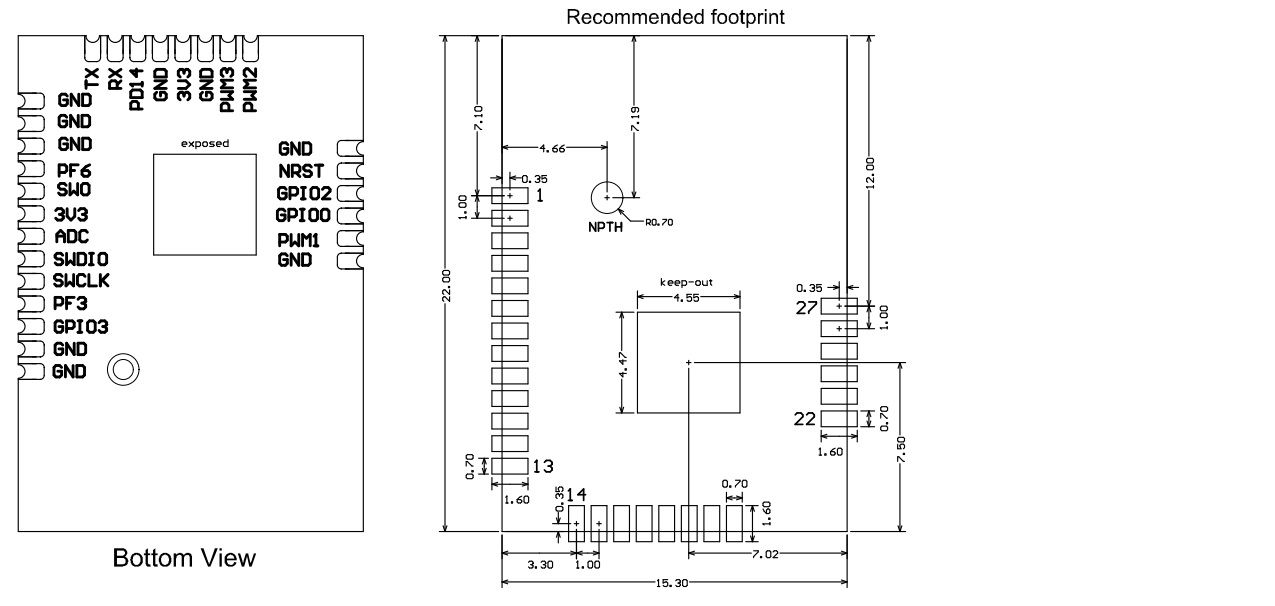
Recommended PCB footprint
The schematic diagram of footprint:
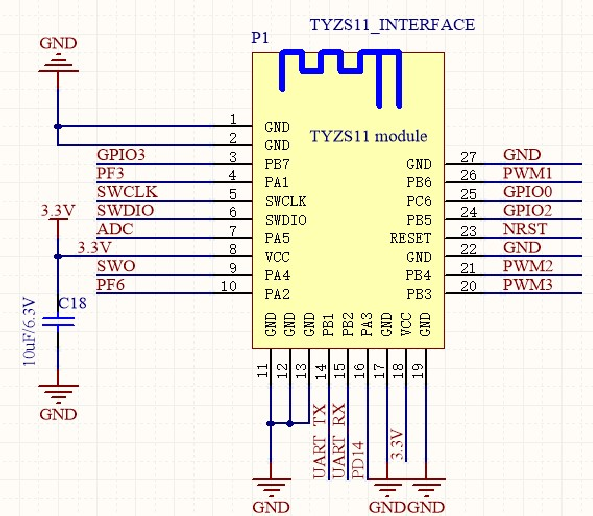
Recommended PCB footprint

Production instructions
- The Tuya SMT module should be mounted by the SMT device. After being unpacked, it should be soldered within 24 hours. Otherwise, it should be put into the drying cupboard where the RH is not greater than 10%; or it needs to be packaged under vacuum again and the exposure time needs to be recorded (the total exposure time cannot exceed 168 hours).
- SMT devices:
- Mounter
- SPI
- Reflow soldering machine
- Thermal profiler
- Automated optical inspection (AOI) equipment
- Baking devices:
- Cabinet oven
- Anti-electrostatic and heat-resistant trays
- Anti-electrostatic and heat-resistant gloves
- SMT devices:
- Storage conditions for a delivered module:
-
The moisture-proof bag must be placed in an environment where the temperature is below 40°C and the relative humidity is lower than 90%.
-
The shelf life of a dry-packaged product is 12 months from the date when the product is packaged and sealed.
-
There is a humidity indicator card (HIC) in the packaging bag.
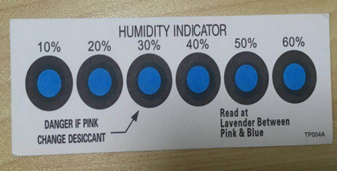
-
- The module needs to be baked in the following cases:
- The packaging bag is damaged before unpacking.
- There is no HIC in the packaging bag.
- After unpacking, circles of 10% and above on the HIC become pink.
- The total exposure time has lasted for over 168 hours since unpacking.
- More than 12 months have passed since the sealing of the bag.
- Baking settings:
- Temperature: 60°C and ≤ 5% RH for reel package and 125°C and ≤5% RH for tray package (please use the heat-resistant tray rather than plastic container)
- Time: 48 hours for reel package and 12 hours for tray package
- Alarm temperature: 65°C for reel package and 135°C for tray package
- Production-ready temperature after natural cooling: < 36°C
- Re-baking situation: If a module remains unused for over 168 hours after being baked, it needs to be baked again.
- If a batch of modules is not baked within 168 hours, do not use the reflow soldering to solder them. Because these modules are Level-3 moisture-sensitive devices, they are very likely to get damp when exposed beyond the allowable time. In this case, if they are soldered at high temperatures, it may result in device failure or poor soldering.
- In the whole production process, take electrostatic discharge (ESD) protective measures.
- To guarantee the passing rate, it is recommended that you use the SPI and AOI to monitor the quality of solder paste printing and mounting.
Recommended oven temperature curve
Perform mounting with the SMT based on the following reflow oven temperature curve. The highest temperature is 245°C. The reflow temperature curve is as below:

-
A: Temperature axis
-
B: Time axis
-
C: Liquidus temperature: 217 to 220°C
-
D: Ramp-up slope: 1 to 3°C/s
-
E: Duration of constant temperature: 60 to 120s; the range of constant temperature: 150 to 200°C
-
F: Duration above the liquidus: 50 to 70s
-
G: Peak temperature: 235 to 245°C
-
H: Ramp-down slope: 1 to 4°C/s
Note: The above curve is just an example of the solder paste SAC305. For more details about other solder pastes, please refer to Recommended oven temperature curve in the solder paste specifications.
Storage conditions
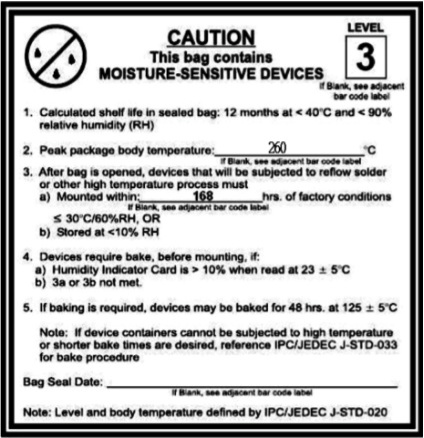
MOQ and packaging information
| Product model | MOQ (pcs) | Packing method | Number of modules per reel | Number of reels per carton |
|---|---|---|---|---|
| TYZS11 | 6400 | Tape reel | 1600 | 4 |
Is this page helpful?
YesFeedbackIs this page helpful?
YesFeedback

